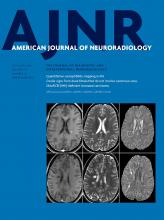Abstract
BACKGROUND AND PURPOSE: Arrested sphenoid pneumatization is an incidental radiologic finding on CT and MR imaging that may be confused with more aggressive pathologic conditions. No definite etiology for arrested sphenoid pneumatization has been established, though changes in regional blood flow during childhood, as is seen with sickle cell disease, have been proposed. The purpose of our study was to compare the prevalence of arrested pneumatization of the sphenoid sinus in patients with and without sickle cell disease.
MATERIALS AND METHODS: We retrospectively identified 146 patients with sickle cell disease who had undergone CT scans of the skull base between January 1990 and May 2015. We identified 292 control patients without sickle cell disease matched for age and sex in a 1:2 ratio. We tabulated the prevalence of arrested pneumatization as well as the location and size of the lesions. We used the Fisher exact test to correlate sickle cell disease with arrested pneumatization of the sphenoid sinus and the t test to correlate sickle cell disease with lesion size.
RESULTS: Of the 146 patients with sickle cell disease, 14 (9.6%) had arrested pneumatization of the sphenoid sinus. In the 292 control patients, 6 (2.1%) had arrested pneumatization. Patients with sickle cell disease had a statistically significant higher rate of arrested pneumatization compared with patients without sickle cell disease (P < .001). There was no statistically significant correlation between lesion size and diagnosis of sickle cell disease.
CONCLUSIONS: Patients with sickle cell disease have a greater prevalence of arrested pneumatization of the sphenoid sinus than patients without sickle cell disease. This supports the theory that either regional blood flow anomalies or increased serum erythropoietin causes arrested sinus pneumatization.
ABBREVIATION:
- SCD
- sickle cell disease
- © 2016 by American Journal of Neuroradiology












